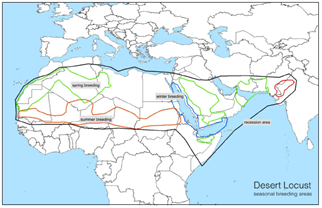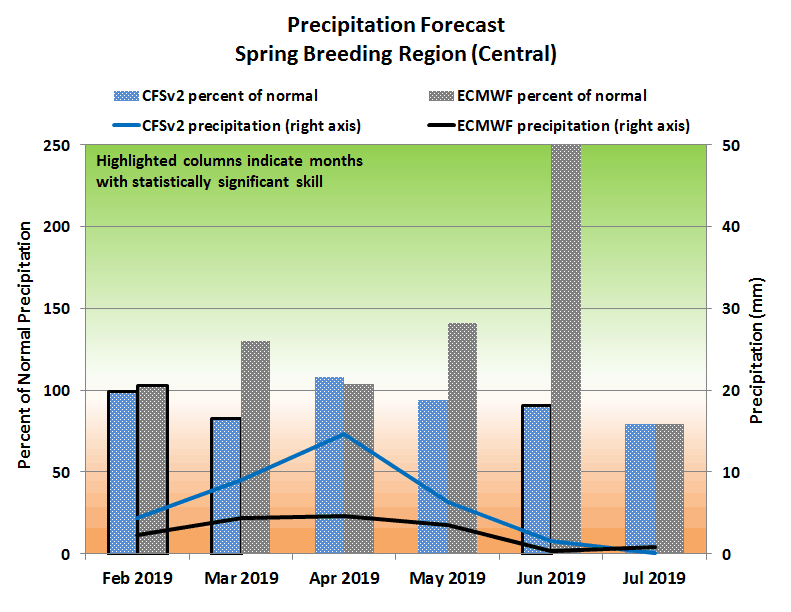Long Lead Forecasts from the World Climate Service to Protect African Food Sources
UN FAO: The Customer
“Temperature is not that important. It’s already too hot in Sub-Saharan Africa. Precipitation is much more important because of its impact on soil moisture. That’s why your forecasts are so important”, explained Keith Cressman, leader of the UN Food and Agriculture Organization’s (FAO) Desert Locust Information Service (DLIS) while reviewing the salient features of the World Climate Service. The FAO DLIS is responsible for monitoring and forecasting Desert Locust outbreaks and plagues in Sub-Saharan Africa, the Near East and southwest Asia and provides early warning to affected countries and the global community. FAO also coordinates the response during locust plagues.

Figure 1. Regions susceptible to locust outbreaks
According to “Weather and Desert Locusts”[1], a joint publication by the UN’s FAO and World Meteorological Organization (WMO), “the Desert Locust has the potential to damage the livelihoods of one-tenth of the world’s population. A swarm the size of Bamako (Mali) or Niamey (Niger) can consume what half the population of either country would eat in a single day”. The risk of Desert Locust outbreaks is very real and can have significant and long-lasting impacts.
“When plentiful rainfall and annual green vegetation develop, Desert Locusts can increase rapidly in number and, within a month or two, start to concentrate and become gregarious. Unless checked, this can lead to bands of wingless numphs and swarms of winged adults.”[2] All locust development phases benefit from the moist conditions rainfall provides.
S2S Forecasts: The Product
The UN FAO DLIS mission is to monitor, forecast, and warn of the development of Desert Locust populations across a significant portion of the face of the Earth. While many factors contribute to a Desert Locust outbreak, precipitation is a critical ingredient. Mr. Cressman surveys a number of sources of weather information to see what has happened and is happening on a day-to-day basis. The World Climate Service (WCS), however, provides him with an important toolset for long-lead forecasting of precipitation events weeks and months in advance. The WCS Subseasonal product, which provides forecasts 2 to 6 weeks in advance, and the companion Seasonal product, which provides forecasts for 1 to 6 months in advance, help Mr. Cressman better understand the risks of the greater than normal precipitation that could potentially lead to the development of Desert Locust outbreaks.
Despite having access to seasonal forecasts provided by well-funded, academic institutions, Mr. Cressman continues to rely on the World Climate Service for his subseasonal/seasonal forecasting needs. “It just fits our needs better.”

Figure 2. An example week 3 precipitation forecast for northern Africa and the Middle East.
WCS: The Technology
In the 31 years Mr. Cressman has been forecasting Desert Locust outbreaks and plagues, technology has revolutionized the quality and speed of information available. DLIS intelligence used to consist of notes scribbled on paper and mailed to Rome, taking weeks to arrive. Now data flows instantly using satellite communications to deliver real-time observations on an electronic tablet in the field. This advancement provides the right information at the right time to improve FAO DLIS warning capabilities and critical national decision making.
The increase in data availability is managed within a Geographic Information System (GIS) to improve the analysis of the information in the spatial context required. Mr. Cressman indicated that “the GIS allows us to integrate the World Climate Service forecasts directly into our decision-making and early warning process. I’ve learned how best to use and interpret the forecasts since starting to use WCS in 2006.”

Figure 3. Integration of the World Climate Service seasonal forecast information directly into the DLIS GIS system.
Desert Locust Information and Communication

Figure 4. Monthly precipitation forecast for a region important for Desert Locust development.
Communication of information to countries susceptible to Desert Locust outbreaks and plagues is a critical aspect of Mr. Cressman’s mission. After receiving the monthly seasonal forecast update, Mr. Cressman prepares a short information piece to update locust-affected countries on the likelihood of precipitation. That communication provides a specialized seasonal forecast analysis for specific regions at risk of locust development. An example of a specialized graphical forecast developed by the World Climate Service is shown in Figure 4.
This type of guidance supports national monitoring and response efforts by providing specific information that indicates the potential for increased risks of Desert Locust outbreaks in the near future.
The Conclusion
Prescient Weather is proud to provide the World Climate Service for such an important application. We look forward to many more years of supporting the UN FAO DLIS in its critical mission.
[1] Weather and Desert Locusts, World Meteorological Organization and the UN Food and Agriculture Organization, WMO No. 1175, 2016
[2] Ibid